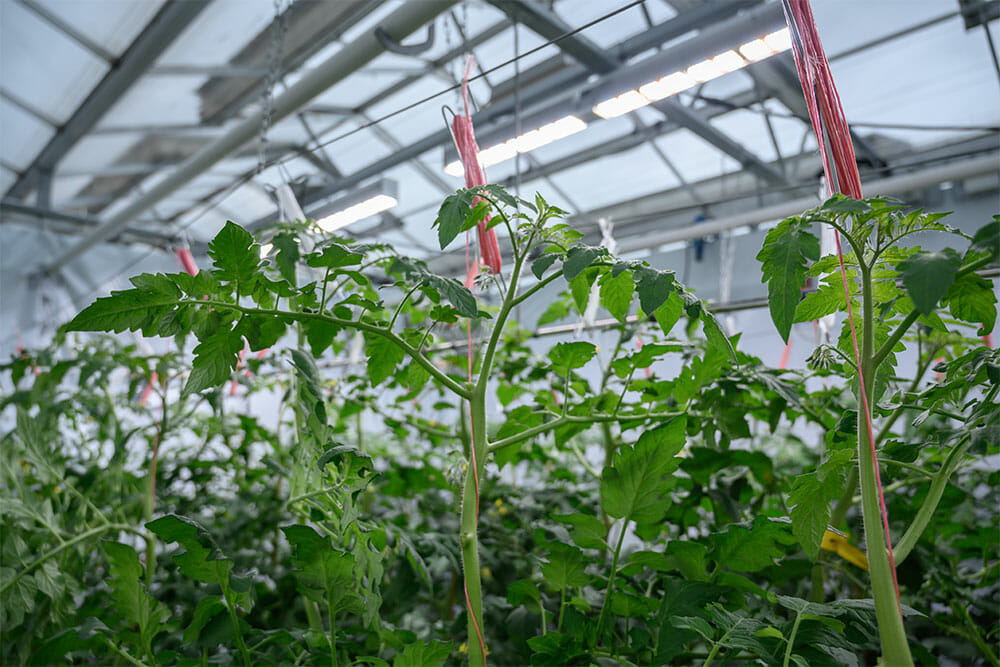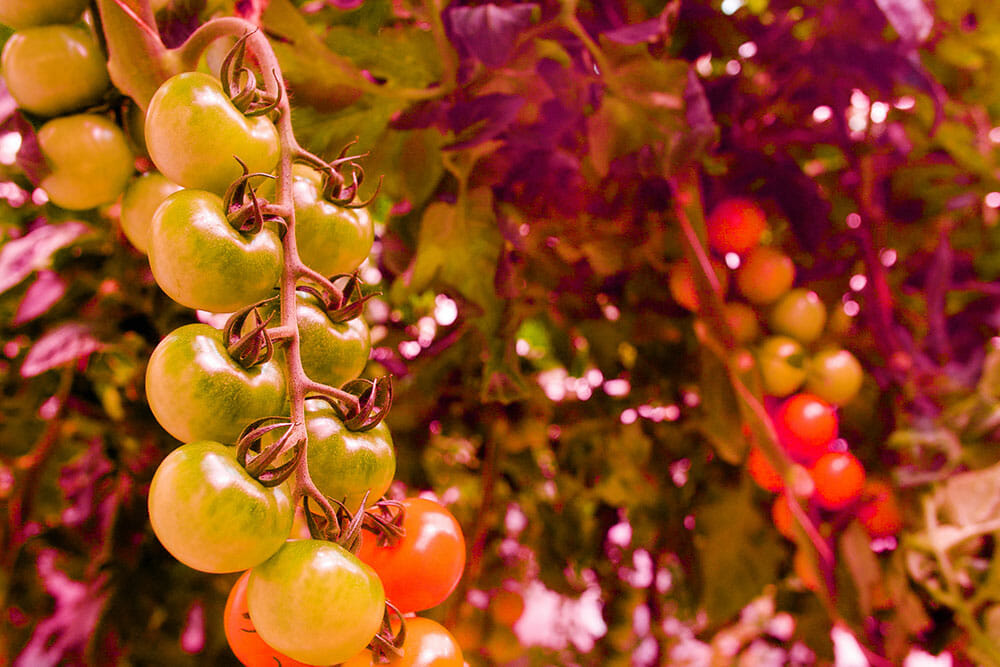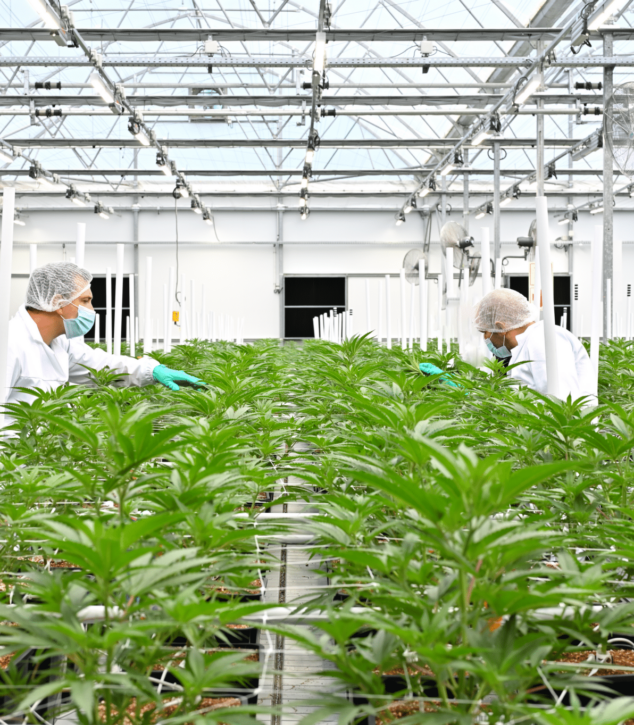During the 2019 – 2020 winter season, Fluence and researchers at Wageningen University and Research (WUR) conducted a study seeking to answer a common question from tomato cultivators throughout the world: With all the different LED spectra on the market, what impact do different supplemental lighting spectra have on tomato production?
“Horticulture is an important economic driver here in the Netherlands. Our partnerships with technology providers like Fluence are essential in driving the industry forward in a more efficient and sustainable way.”
– Leo Marcelis, Professor of Horticulture, Wageningen University & Research
Tomato cultivators have long used top-light strategies to supplement lower daily light integrals during the fall and winter months. Year-round production ensures greenhouse growers can fulfill market demand for reliable and fresh tomatoes while capitalizing on the crop’s typically higher price during winter months. As the industry migrates toward LED lighting technologies in place of legacy solutions such as high-pressure sodium (HPS) lamps, cultivators are taking advantage of optimizing supplemental lighting with LEDs’ higher efficacy, lower overall operational costs, reduced year-over-year maintenance expenses, and spectral options optimized for an operation’s cultivation goals.
Fluence and Wageningen University’s collaborative study compared the impact and influence of four supplemental light spectra in a tomato greenhouse on fruit yield and quality throughout a single winter growing season. The research team collaborated with leading crop consulting firm Vortus Greenhouse Consultants to ensure the study was conducted in a method that meets both the research design approach and commercial crop production.
The Experiment
The study evaluated differences in yield, morphology, development and quality for two tomato cultivars—Merlice and Brioso—grown under four light qualities ranging from a broad-white spectrum to a narrow-band red and blue spectrum (Figure 1). The study was conducted with lead researchers Leo Marcelis and Ep Heuvelink in the 2019 – 2020 winter season under Fluence’s VYPR series supplemental lighting solution. The experiment was executed as a randomized complete block design with 3 replicates (Figure 2). Environmental conditions are detailed in Figure 3.
Spectra Charts (Figure 1)

Four different spectra were used in our study. These spectra on the VYPR Series are R4, R6, R8, and R9B. The spectra chart shows two treatments; broad white R4 and red/blue R9B. Learn more about Fluence PhysioSpecTM.
Experimental Design (Figure 2)
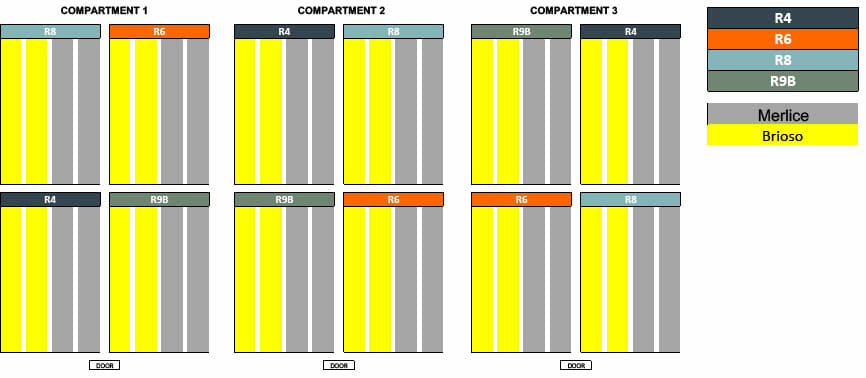
In a bit more detail for the layout, here are again the 3 compartments. As we believe in good science and correct statistical analysis, we repeated the experiment 3 times. So the 3 compartments you see are three actual replications. In Compartment 1 you see the 4 treatments, and then the treatments were rotated in the other compartments so they do not fall on the same place, hence we avoid potential pitfalls of walls, (side) left/right, (depth) back/front etc. With grey you see the cultivar Merlice and with yellow the cultivar Brioso (each row is a gutter).
Environmental Conditions (Figure 3)
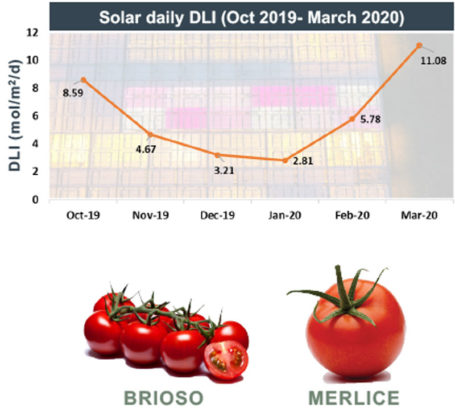
Table 1
| Parameters | Value |
|---|---|
| PPFD (µmol/m2/s) | 250 |
| Photoperiod (h) | 16 |
| DLI LEDs (mol/m2/d) | ~13 (75% of total light sum ) |
| Cultivars | Merlice and Brioso |
| Temperature (oC) | 21 morning, 25 afternoon,16 night |
| Relative humidity (%) | 60-85% |
| [CO2] setpoint (ppm) | 600 until fruiting, 750+ after fruiting) |
| pH | 5.5-6 |
| EC (µS) | 3 (Merlice), 3.5 (Brioso) |
| Plant density | 2.74 plants/m2 |
Results + Analysis
Yield
Brioso: Crops grown under R8 produced the highest yield. We also observed a slight decrease in yield under R6 and R9B (lower and higher red content, respectively).
Merlice: Crops under broad R4 produced the highest yield with the most significant difference resulting in a 14% increase in yield. As the spectra’s red percentage increased, we observed a linear decrease in yield.
Individual Fruit Weight
Brioso: For both cultivars, crops were produced with average fruit weights. For Brioso, individual fruit weight was largely unaffected by various spectra.
Merlice: In contrast to Brioso, the Merlice cultivar produces lower fruit weights as the spectra’s red percentage increased. Broad R4 produced the highest fruit weight with a 13% increase as compared to Dual R9B.
Brix Value
Overall, we observed higher Brix values within the Brioso cultivar under the broad R4 spectrum. Notably in January and February—where DLI nearly doubles month to month—we observed strong Brix values under R4, indicating that growers can benefit from broad-white spectra in the darkest months of the year.
Contact us now to determine the right light spectra for you.
Key Takeaway: Broad-spectra supplemental lighting resulted in higher fruit weight, higher Brix values in darker months and overall higher yields.
“As LEDs are becoming more cost effective for commercial applications, it is important to understand the impact of light on fruit yield. This is why we have partnered with Fluence, to test all options on the market, not just broad or narrow band.”
Ep Heuvelink, Associate Professor, Wageningen University & Research
LEDs are unique in their ability to amplify key wavelengths of light and therefore elicit powerful responses from tomato plants. It is particularly interesting to observe how—solely through spectral optimization—certain tomato cultivars can experience up to a 14% increase in overall yield under broad spectra (R4) as compared to light treatments with upwards of 90% red light (R9B).
Fluence’s research illustrates that supplemental lighting spectra considerations are largely cultivar-specific, as differing spectra have shown to increase yields for certain tomato cultivars. Although Fluence’s collaborative study confirms that broad-spectrum LEDs balance energy efficiency and fruit yield to produce higher yields, growers should engage with the Fluence sales and horticulture services teams to determine the supplemental lighting spectra best suited to meet their cultivation goals. Lighting is application and grower specific. Lighting decisions should be based not only on leading academic studies, but should also consider the growers geography, availability to energy, selected crop and cultivars, and operational considerations within their greenhouse to identify the lighting strategy best suited for the grower’s cultivation goals. By weighing these components, choosing the right spectra will result in improved yields and quality, ultimately increasing financial returns.
Contact a Fluence specialists today to learn more about the trial and the valuable insights learned regarding tomato plant quality and how the different cultivars growth changed throughout the winter months! Contact us here.

Fluence research
The Fluence Research team conducts studies through partnerships with leading research groups around the world while also conducting research in-house at the company’s Photobiology and Research Lab in Austin, Texas. Fluence partners with industry consultants to advise on the commercial viability of the team’s research studies while concurrently proving our lighting solutions at commercial scale through grower case studies led by Fluence’s Horticultural Services team.

Research Partner
More than 100 years of experience
Located at the center of horticulture innovation in the Netherlands
Cultivate under modern greenhouses and partner with crop consultants

Research Partner
Global cultivation support consulting group with over 35 years of experience
Collaborative approach leveraging research to apply to commercial crop production
Specialize in vegetable fruits, leafy greens, cut flowers, breeding, propagation, and organic production





